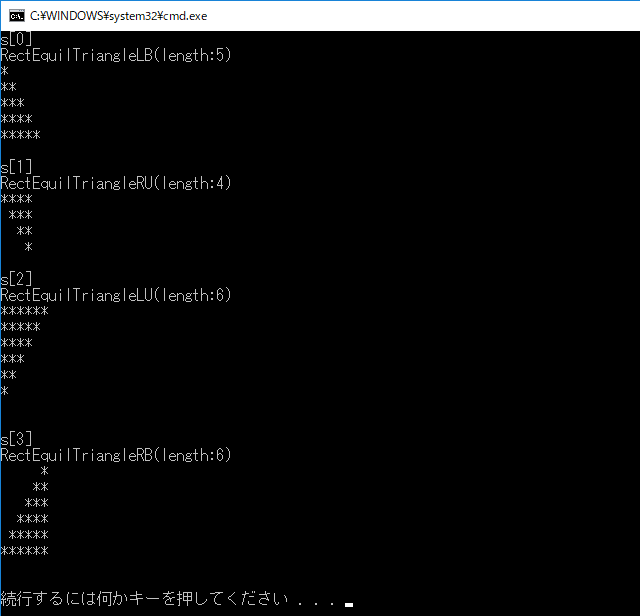新規記事の投稿を行うことで、非表示にすることが可能です。
2017年12月31日
《その214》 クロスキャスト(2) & p.259演習7-3
クロスキャスト
クラス C は、多重継承により、クラス A から純粋仮想関数 fa を、クラス B から純粋仮想関数 fb を受け継いでいます。下のプログラムです。
クラス C のオブジェクトは、2つの整数値 x, y をデータメンバに持ち、
関数 fa は和 x+y を、
関数 fb は差 x - y を、
それぞれ返却します。
main関数では、C型オブジェクトを3つ生成して、それらを、
A*型のポインタ a[0], a[1], a[2] が指しています。
その結果、例えば、
A[0]->fa();
とすれば、メンバ関数 fa を呼び出すことができます。しかし、
A[0]->fb();
でメンバ関数 fb を呼び出すことはできません。
関数 fb は、クラス A からではなく、クラス B から受け継いだものだからです。
そこで、ポインタ A[0] を A*型から B*型にキャストすることにします。
クラス A とクラス B は、まったく別のクラスで、親子関係もありませんから、本来であればキャストは不可能です。
ところが、クラス A, B には、共通の子クラス C が存在します。
このようなときには、dynamic_cast<>演算子を用いてキャストを成功させることができます。
この形式のキャストは、クロスキャストと呼ばれます。
他人だったときにはキャストできなかった男女 A, B に、共通の子供 C ができると、A, B は、もう他人ではないのでキャストが可能になる、といった感じでしょうか (∩。∩;)ゞ
B* p = dynamic_cast<B*>(a[0]);
p->fb();
で、メンバ関数 fb を呼び出すことが可能になります。
// ------------------------------------
#include <iostream>
using namespace std;
class A {
public:
virtual int fa() = 0;
};
class B {
public:
virtual int fb() = 0;
};
class C : public A, public B {
int x;
int y;
public:
C(int s, int t) : x(s), y(t) { }
int fa() { return x + y; }
int fb() { return x - y; }
};
int main()
{
A* a[] = {
new C(20, 10),
new C(50, 30),
new C(66, 33),
};
for (int i = 0; i < 3; i++)
cout << a[i]->fa() << " ";
cout << '\n';
for (int i = 0; i < 3; i++) {
B* p = dynamic_cast<B*>(a[i]);
cout << p->fb() << " ";
}
cout << '\n';
for (int i = 0; i < 3; i++)
delete a[i];
}
// ------------------------------------

新版明解C++中級編 p.259 演習7-3
次のプログラムに、左上直角の二等辺三角形 RectEquilTriangleLU と右下直角の二等辺三角形 RectEquilTriangleRB を作成して加えよ。
// ------------------------------------
#include <string>
#include <sstream>
#include <iostream>
// 図形クラス(抽象クラス)
class Shape {
public:
virtual ~Shape() = 0;
virtual Shape* clone() const = 0;
virtual void draw() const = 0;
virtual std::string to_string() const = 0;
void print() const {
std::cout << to_string() << '\n';
draw();
}
virtual void debug() const = 0;
};
inline Shape::~Shape() { }
inline void Shape::debug() const {
std::cout << "-- デバッグ情報 --\n";
std::cout << "型:" << typeid(*this).name()
<< '\n';
std::cout << "アドレス:" << this << '\n';
}
// 挿入子の多重定義
inline std::ostream& operator<<(
std::ostream& os,
const Shape& s
) {
return os << s.to_string();
}
// 2次元クラス(抽象クラス)
class TwoDimensional {
public:
virtual ~TwoDimensional() = 0;
virtual double get_area() const = 0;
};
inline TwoDimensional::~TwoDimensional() {}
// 直角二等辺三角形クラス(抽象クラス)
class RectEquilTriangle
: public Shape, public TwoDimensional {
protected:
int length;
public:
RectEquilTriangle(int len) : length(len) { }
double get_area() const {
return length * length / 2.0;
}
};
// 左下直角二等辺三角形クラス
class RectEquilTriangleLB
: public RectEquilTriangle {
public:
RectEquilTriangleLB(int len)
: RectEquilTriangle(len) { }
RectEquilTriangleLB* clone() const {
return new RectEquilTriangleLB(length);
}
void draw() const {
for (int i = 1; i <= length; i++) {
for (int j = 1; j <= i; j++)
std::cout << '*';
std::cout << '\n';
}
}
std::string to_string() const {
std::ostringstream os;
os << "RectEquilTriangleLB(length:"
<< length << ")";
return os.str();
}
void debug() const {
Shape::debug();
std::cout << "クラス:RectEquilTriangleLB\n";
std::cout << "アドレス" << this << '\n';
std::cout << "length:" << length << '\n';
}
};
// 右上直角二等辺三角形クラス
class RectEquilTriangleRU
: public RectEquilTriangle {
public:
RectEquilTriangleRU(int len)
: RectEquilTriangle(len) { }
RectEquilTriangleRU* clone() const {
return new RectEquilTriangleRU(length);
}
void draw() const {
for (int i = 1; i <= length; i++) {
for (int j = 1; j <= i - 1; j++)
std::cout << ' ';
for (int j = 1; j <= length - i + 1; j++)
std::cout << '*';
std::cout << '\n';
}
}
std::string to_string() const {
std::ostringstream os;
os << "RectEquilTriangleRU(length:"
<< length << ")";
return os.str();
}
void debug() const {
Shape::debug();
std::cout << "クラス:RectEquilTriangleRU\n";
std::cout << "アドレス" << this << '\n';
std::cout << "length:" << length << '\n';
}
};
int main()
{
Shape* s[] = {
new RectEquilTriangleLB(5), // 左下直角
new RectEquilTriangleRU(4), // 右上直角
};
for (int i = 0; i < sizeof(s) / sizeof(s[0]); i++) {
std::cout << "s[" << i << "]\n";
s[i]->print();
std::cout << '\n';
}
for (int i = 0; i < sizeof(s) / sizeof(s[0]); i++)
delete s[i];
}
// ------------------------------------
以下が、解答のプログラムです。
#include <string>
#include <sstream>
#include <iostream>
// 図形クラス(抽象クラス)
class Shape {
public:
virtual ~Shape() = 0;
virtual Shape* clone() const = 0;
virtual void draw() const = 0;
virtual std::string to_string() const = 0;
void print() const {
std::cout << to_string() << '\n';
draw();
}
virtual void debug() const = 0;
};
inline Shape::~Shape() { }
inline void Shape::debug() const {
std::cout << "-- デバッグ情報 --\n";
std::cout << "型:" << typeid(*this).name()
<< '\n';
std::cout << "アドレス:" << this << '\n';
}
// 挿入子の多重定義
inline std::ostream& operator<<(
std::ostream& os,
const Shape& s
) {
return os << s.to_string();
}
// 2次元クラス(抽象クラス)
class TwoDimensional {
public:
virtual ~TwoDimensional() = 0;
virtual double get_area() const = 0;
};
inline TwoDimensional::~TwoDimensional() {}
// 直角二等辺三角形クラス(抽象クラス)
class RectEquilTriangle
: public Shape, public TwoDimensional {
protected:
int length;
public:
RectEquilTriangle(int len) : length(len) { }
double get_area() const {
return length * length / 2.0;
}
};
// 左下直角二等辺三角形クラス
class RectEquilTriangleLB
: public RectEquilTriangle {
public:
RectEquilTriangleLB(int len)
: RectEquilTriangle(len) { }
RectEquilTriangleLB* clone() const {
return new RectEquilTriangleLB(length);
}
void draw() const {
for (int i = 1; i <= length; i++) {
for (int j = 1; j <= i; j++)
std::cout << '*';
std::cout << '\n';
}
}
std::string to_string() const {
std::ostringstream os;
os << "RectEquilTriangleLB(length:"
<< length << ")";
return os.str();
}
void debug() const {
Shape::debug();
std::cout << "クラス:RectEquilTriangleLB\n";
std::cout << "アドレス" << this << '\n';
std::cout << "length:" << length << '\n';
}
};
// 右上直角二等辺三角形クラス
class RectEquilTriangleRU
: public RectEquilTriangle {
public:
RectEquilTriangleRU(int len)
: RectEquilTriangle(len) { }
RectEquilTriangleRU* clone() const {
return new RectEquilTriangleRU(length);
}
void draw() const {
for (int i = 1; i <= length; i++) {
for (int j = 1; j <= i - 1; j++)
std::cout << ' ';
for (int j = 1; j <= length - i + 1; j++)
std::cout << '*';
std::cout << '\n';
}
}
std::string to_string() const {
std::ostringstream os;
os << "RectEquilTriangleRU(length:"
<< length << ")";
return os.str();
}
void debug() const {
Shape::debug();
std::cout << "クラス:RectEquilTriangleRU\n";
std::cout << "アドレス" << this << '\n';
std::cout << "length:" << length << '\n';
}
};
// 左上直角二等辺三角形クラス
class RectEquilTriangleLU
: public RectEquilTriangle {
public:
RectEquilTriangleLU(int len)
: RectEquilTriangle(len) { }
RectEquilTriangleLU* clone() const {
return new RectEquilTriangleLU(length);
}
void draw() const {
for (int i = length; i >= 1; i--) {
for (int j = 1; j <= i; j++)
std::cout << '*';
std::cout << '\n';
}
std::cout << '\n';
}
std::string to_string() const {
std::ostringstream os;
os << "RectEquilTriangleLU(length:"
<< length << ")";
return os.str();
}
void debug() const {
Shape::debug();
std::cout << "クラス:RectEquilTriangleLU\n";
std::cout << "アドレス" << this << '\n';
std::cout << "length:" << length << '\n';
}
};
// 右下直角二等辺三角形クラス
class RectEquilTriangleRB
: public RectEquilTriangle {
public:
RectEquilTriangleRB(int len)
: RectEquilTriangle(len) { }
RectEquilTriangleRB* clone() const {
return new RectEquilTriangleRB(length);
}
void draw() const {
for (int i = 1; i <= length; i++) {
for (int j = 1; j <= length - i; j++)
std::cout << ' ';
for (int j = 1; j <= i; j++)
std::cout << '*';
std::cout << '\n';
}
std::cout << '\n';
}
std::string to_string() const {
std::ostringstream os;
os << "RectEquilTriangleRB(length:"
<< length << ")";
return os.str();
}
void debug() const {
Shape::debug();
std::cout << "クラス:RectEquilTriangleRB\n";
std::cout << "アドレス" << this << '\n';
std::cout << "length:" << length << '\n';
}
};
int main()
{
Shape* s[] = {
new RectEquilTriangleLB(5), // 左下直角
new RectEquilTriangleRU(4), // 右上直角
new RectEquilTriangleLU(6), // 左上直角
new RectEquilTriangleRB(6), // 右下直角
};
for (int i = 0; i < sizeof(s) / sizeof(s[0]); i++) {
std::cout << "s[" << i << "]\n";
s[i]->print();
std::cout << '\n';
}
for (int i = 0; i < sizeof(s) / sizeof(s[0]); i++)
delete s[i];
}




